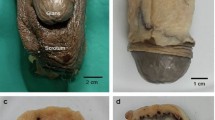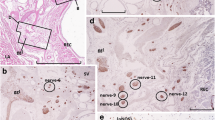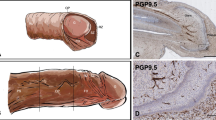Summary
Neuropeptide Y 1–36 (IR-NPY) immunoreactive nerve-fiber processes have been observed in tunicae of veins and arteries and in smooth muscles of the human penis taken at autopsy or during surgery by use of light-and electron-microscopic immunohistochemical techniques. Numerous IR-NPY nerve fibers were mostly concentrated in the inner part of the adventitia close to the media of the arterial and venous vessels and among the intracavernous smooth muscle cells. IR-NPY nerve fibers were less abundant in veins than in arteries. Positive somata were not observed in the penises. At the ultrastructural level, IR-NPY were localized exclusively in large, dense granules of nerve terminals by means of the postembedding immunogold technique. In the deep dorsal vein, IR-NPY nerve fibers were also located in the media formed by an outer circular and an inner longitudinal layer. In the intracavernous and dorsal arteries, they showed the highest density in the inner part of the adventitia. In the corpora cavernosa and in the corpus spongiosum, IR-NPY nerve processes were intermingled between the smooth-muscle fibers around the sinusoid spaces. IR-NPY nerve fibers were present in the cavernous nerves close to the central arteries. The urethra did not show any IR-NPY-positive nerve fibers. This peculiar distribution of IR-NPY nerve fibers suggested that they could participate in regulating arterial and venous blood flow and intracavernous smooth-muscle tone. NPY may therefore be of importance in some of the mechanisms of penile erection especially during detumescence.
Similar content being viewed by others
References
Aggestrup S, Uddman R, Jensen SL, Håkanson R, Sundler F, Schaffalitzky de Muckadell O, Emson P (1986) Regulatory peptides in lower esophageal sphincter of pig and man. Dig Dis Sci 31:1370–1375
Allen JM, Adrian TE, Tatemoto K, Polak JM, Hughes J, Bloom SR (1982) Two novel related peptides, neuropeptide Y (NPY) and peptide YY (PYY) inhibit the contraction of the electrically stimulated mouse vas deferens. Neuropeptides 3:71–77
Alm P, Alumets J, Håkanson R, Sundler F (1977) Peptidergic (vasoactive intestinal peptide) nerves in the genito-urinary tract. Neuroscience 2:751–754
Casey W, Woods R (1980) Anatomy and histology of penile deep dorsal in venous cushions and proximal sphincter. Urology 19:284–286
De Mey J (1983) A critical review of light and electron microscopic immunohistochemical techniques used in neurobiology. J Neurosci Methods 7:1–18
Edvinsson L, Emson P, McCulloch J, Tatemoto K, Uddman R (1983) Neuropeptide Y: cerebrovascular innervation and vasoactive effects in cat. Neurosci Lett 43:79–84
Edvinsson L, Håkanson R, Steen S, Sundler F, Uddman R, Wahlestedt C (1985) Innervation of human omental arteries and veins and vasomotor response to noradrenaline, neuropeptide Y, substance P and vasoactive intestinal peptide. Regul Pept 12:67–79
Ekblad E, Edvinsson L, Wahlestedt C, Uddman R, Håkanson R, Sundler F (1984) Neuropeptide Y coexists and co-operates with noradrenaline in perivascular nerve fibers. Regul Pept 8:225–235
Fournier GR, Juenemann KP, Lue TF, Tanagho E (1987) Mechanism of venous occlusion during canine penile erection: an anatomic demonstration. J Urol 137:163–166
Klinge E, Sjöstrand N (1977) Comparative study of some isolated mammalian smooth muscle effectors of penile erection. Acta Physiol Scand 100:354–367
Larsen J-J, Ottesen B, Fahrenkrug J, Fahrenkrug L (1981) Vasoactive intestinal polypeptide (VIP) in the male genito-urinary tract, concentration and motor effect. Invest Urol 19:211–213
Larsson L-I (1977) Occurrence of nerves containing vasoactive intestinal polypeptide immunoreactivity in the male genital tract. Life Sci 21:503–508
Lundberg JM, Tatemoto K (1982) Pancreatic polypeptide family (APP, BPP, NPY and PYY) in relation to sympathetic vasoconstriction resistant to adrenoceptor blockade. Acta Physiol Scand 116:393–402
Lundberg JM, Torssell L, Sollevi A, Pernow J, Theodorsson Norheim E, Anggard A, Hamberger B (1985) Neuropeptide Y and sympathetic vascular control in man. Regul Pept 13:41–52
Pelletier G, Desy L, Kerkerian L, Cote J (1984) Immunocytochemical localization of neuropeptide Y (NPY) in the human hypothalamus. Cell Tissue Res 238:203–205
Polak JM, Gu J, Mina S, Bloom SR (1981) VIPergic nerves in the penis. Lancet 2:217–219
Roth J, Ravazzola M, Bendayan M, Orci L (1981) Application of the proteine A-gold technique for electron microscopic demonstration of polypeptide hormones. Endocrinology 108:247–253
Steers WD, McConnel J, Benson GS (1984) Anatomical and some pharmacological effects of vasoactive intestinal polypeptide in human and monkey corpus cavernosum. J Urol 132:1048–1052
Sternberger LA (1979) The unlabelled antibody peroxydase-antiperoxidase (PAP) method. In: Sternberger LA (ed) Immunocytochemistry. 2nd ed, Wiley Med Pub, New York, pp 57–61
Stjernquist M, Hakanson R, Leander S, Owman C, Sundler F, Uddman R (1983) Immunohistochemical localization of substance P, vasoactive intestinal polypeptide and gastrin-releasing peptide in vas deferens and seminal vesicle, and the effect of these and eight other neuropeptides on the resting tension and neurally evoked contractile activity. Regul Pept 7:67–86
Tatemoto K (1982) Neuropeptide Y: Complete amino acid sequence of the brain peptide. Proc Natl Acad Sci USA 79:5485–5489
Tudoriu T, Bourmer H (1983) The hemodynamics of erection at the level of the penis and its local deterioration. J Urol 129:741–745
Virag R, Ottesen B, Levy C, Wagner G (1982) Vasoactive intestinal polypeptide release during penile erection in man (letter). Lancet 2:1166–1167
Wespes E, Schulman C (1986) Hemodynamic role of the tunica albuginea in erection. Acta Urol Belgica 54:114–122
Wespes E, Depierreux M, Schulman C (1987) Penile deep dorsal vein cushions and erection. Br J Urol 60:174–177
Willis T, Ottesen B, Wagner G, Sundler F, Fahrenkrug J (1981) Vasoactive intestinal polypeptide (VIP) as a possible neurotransmitter involved in penile erection. Acta Physiol Scand 113:545–547
Author information
Authors and Affiliations
Rights and permissions
About this article
Cite this article
Wespes, E., Schiffmann, S., Gilloteaux, J. et al. Study of neuropeptide Y-containing nerve fibers in the human penis. Cell Tissue Res. 254, 69–74 (1988). https://doi.org/10.1007/BF00220018
Accepted:
Issue Date:
DOI: https://doi.org/10.1007/BF00220018




